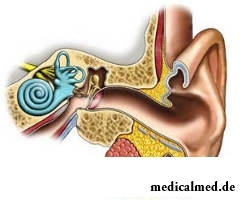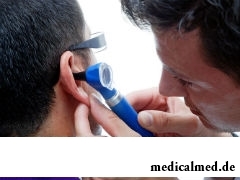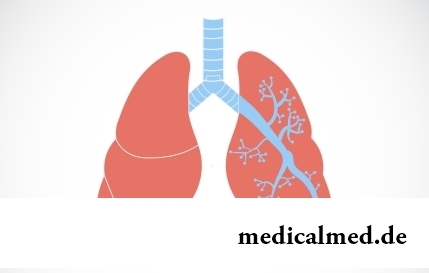





Labyrinthitis
 Labyrinthitis – the disease which is characterized by defeat of internal peripheral departments of sound and vestibular analyzers. Quite often this disease arises at acute inflammations of a middle ear, tuberculosis of a middle ear or is a consequence of an injury.
Labyrinthitis – the disease which is characterized by defeat of internal peripheral departments of sound and vestibular analyzers. Quite often this disease arises at acute inflammations of a middle ear, tuberculosis of a middle ear or is a consequence of an injury.
Symptoms of a labyrinthitis and disease depend on concentration of process in an inner ear. Preferential the labyrinthitis is provoked by an upper respiratory tract infection (flu, a SARS). Sometimes the disease results from an infection of a middle ear. Seldom the labyrinthitis can be caused by a bacterial infection.
Types of a labyrinthitis
The disease is subdivided into the following types:
- Hematogenous labyrinthitis. At this form of a disease contagiums get into an inner ear together with a blood flow.
- Purulent – leukocytic infiltration endo-and perilymphas.
- Diffusion purulent or serous labyrinthitis which can extend to all departments of a bone labyrinth.
- Necrotic at which on a bone labyrinth and soft tissues there are sites of a necrosis.
- Meningogenny arising at meningitis. At this form of a disease the contagium gets from subarachnoid space through a water supply system of a snail.
- Limited labyrinthitis at which there is a defeat of a certain site of a wall of a bone labyrinth.
- Serous at which there is an increase in quantity of a perilympha and the labyrinth endosteum bulks up.
- Acute purulent or serous labyrinthitis at which disturbances of functions of an inner ear happen suddenly.
- Traumatic, being a consequence of an injury (at a gunshot wound, a fracture of base of the skull).
- Chronic labyrinthitis when disturbance of functions of an inner ear happens gradually.
Labyrinthitis symptoms
As it was already told above, symptoms of a labyrinthitis and weight of disease in many respects depend on process localization.
As a rule, at the initial stages of a disease the irritation of a labyrinth showing in the following signs is noted: nausea, dizziness, sonitus, decrease in hearing, vomiting, disorder of balance. Intensity of dizziness depends on a labyrinthitis form. Disorder of balance is observed as at rest, and when walking.
At a serous labyrinthitis such pathological changes as formation of hypostasis in soft parts of a labyrinth and emergence of exudate are observed. If the labyrinthitis passes without complications, then exudate rezorbtsirutsya gradually.
At a limited labyrinthitis presence of a fistula which preferential is located on the horizontal channel is quite often observed. At a purulent form of a disease a symptom of a labyrinthitis is fervescence. And at a diffusion purulent labyrinthitis often there is such complication as total loss of hearing.
If the disease is followed by meningitis and abscess of a cerebellum, then diagnosis of a labyrinthitis is extremely difficult.
At a serous or limited labyrinthitis partial safety of functions of vestibular and cochlear devices is characteristic. At full dissonance of their functions it is possible to speak about a diffusion and purulent labyrinthitis.
Diagnosis of a labyrinthitis
Examination of the patient is conducted after his appeal to hospital with certain complaints. Sometimes apply special tests to identification of the reason of dizziness, but if it does not help to establish the exact reason, as a rule, appoint additional inspection.
At diagnosis of a labyrinthitis an important role is played by the next researches:
- Magnetic and resonant research and computer tomography. By means of these methods it is possible to see whether there is any pathology of a brain.
- Elektronistagmografiya. By means of electrodes registration of the movement of eyeglobes is carried out. If injury of an inner ear is the reason of dizziness, then eyeballs make certain movements. If dizziness is caused by injury of the central nervous system, then eyeballs make other types of movements.
- Hearing research – one more method for detection of a hearing disorder. Here it is possible to carry the BAYER and BSER methods, the test reply of acoustical department of a brainstem which help to define whether the nerve passing from an inner ear to a brain normally works.
- Audiometriya – the method helping to define how well the person hears.
Treatment of a labyrinthitis
 After diagnosis of a labyrinthitis and confirmation of the diagnosis of the patient without fail hospitalize. At treatment of a labyrinthitis the patient has to be under careful control of the attending physician. Absolute rest and an easy diet is recommended to the patient (electrolyte-deficient and anhydrous). For pressure decrease in a labyrinth to the patient appoint urotropin and glucose. The main drugs at treatment of a labyrinthitis are antibiotics which choice depends on sensitivity of flora of a middle ear to them.
After diagnosis of a labyrinthitis and confirmation of the diagnosis of the patient without fail hospitalize. At treatment of a labyrinthitis the patient has to be under careful control of the attending physician. Absolute rest and an easy diet is recommended to the patient (electrolyte-deficient and anhydrous). For pressure decrease in a labyrinth to the patient appoint urotropin and glucose. The main drugs at treatment of a labyrinthitis are antibiotics which choice depends on sensitivity of flora of a middle ear to them.
At a serous form treatment of a labyrinthitis consists in recovery of function of an ear and the prevention of transition of this form to purulent.
At an acute purulent form of a labyrinthitis it is necessary to provide to the patient normal outflow of pus. It becomes by separation of new fabrics from preweb space.
At a limited labyrinthitis for full treatment it is necessary to provide healing of a fistula with a connecting or bone tissue. As a rule, for this purpose perform surgery when from area of a temple delete the pathological center.
For treatment of a labyrinthitis of a hematogenous and meningogenny form appoint antibiotics of a broad spectrum of activity.
Prevention of a labyrinthitis
For prevention of this disease it is necessary to take the appropriate measures for the prevention of the general infectious diseases, and also to treat timely any inflammations of a middle ear.
Average life expectancy of lefthanders is less, than right-handed persons.

The popular expression "run from a heart attack" became the motto of the people supporting active lifestyle. Moreover, run became peculiar...
Section: Articles about health
Antibiotics - - it is possible to call the chemical compounds suppressing growth of bacteria the break in the field of medicine which allowed to save mankind from many diseases incurable earlier: tuberculosis, plague, syphilis and many others. A contribution of drugs to rescue of people from...
Section: Articles about health
The modern person not always manages to find housing in the environmentally friendly region and such work which would not do harm to health. With food stuffs at first sight the situation is much better: shops are overflowed with goods which are positioned by producers as very useful and absolutely safe. Many Russians are absolutely sure that the choice of products with marking "bio", "эко" or "organik" guarantees them and members of their families an optimal variant of food. To a sozhala...
Section: Articles about health
Since the moment when the child becomes a school student, his sight begins to be exposed to the strengthened loadings which are supplemented viewing...
Section: Articles about health
The name of this disease precisely reflects the problem reason: it consists in the bra fastener pressure upon a certain zone of a back. At the same time one of vertebrae of chest department of a backbone is as if blocked and loses mobility, and falling on it is nude...
Section: Articles about health
The Genetically Modified Organisms (GMO) are plants or animals (as a rule, agricultural) to whose genotype purposeful changes were made. Opposition of supporters and opponents of inclusion of such organisms in foodstuff always was very acute. Not only scientists and dietitians, but also a large number of the people who are not specialists in this question are involved in active disputes today....
Section: Articles about health
An eye of the person daily experiences considerable strain. The problem of preservation of sight is for many years directly connected with a question снабж...
Section: Articles about health
Urogenital candidiasis (milkwoman) – a fungal infection which annoys unpleasant feelings in the field of generative organs, being followed by white curdled allocations, an itch, discomfort during an urination, pain. She is called by Candida fungus – a mustache...
Section: Articles about health
Extracorporal fertilization – one of the most modern methods of controlling with infertility. So far he already helped a significant amount of married couples to become happy parents. Usually to the EKO procedure difficult and very expensive, resort in those situations when all other ways to help couple to bring the child are inefficient. "Conception in a test tube" yields quite good results in cases of infertility of one of partners, existence at the woman of impassability of uterine tubes...
Section: Articles about health
The immunity role in growth of the child is invaluable. The proteins-immunoglobulins produced by immune system preserve the child against diseases...
Section: Articles about health
They say that to ensure health and longevity of people it is obliged. Really, at competent approach to these questions, minimization of an adverse effect of many factors does not represent a special problem. Practically everyone has an opportunity to play sports...
Section: Articles about health
Bathing in broths of medical flowers and plants (phytobathtub) was eurysynusic since Cleopatra who is a good judge in all that concerns beauty and health. And today phytobathtubs is the simple and available means allowing not only to remove nervous tension, but also to recover from many diseases. Grass bathtubs at treatment of cold, osteochondrosis, radiculitis, skin diseases, and also diseases of urinary tract and vessels are especially effective....
Section: Articles about health
Proofs of efficiency of Mildronate at treatment of coronary heart disease with stenocardia can be found in many publications to...
Section: Articles about health
All parents are ready to what the baby often and pisat much. Since then, as the absorbing diapers strongly became current, keeping of the kid in dryness does not represent any problems. But if the grown-up kid continues to urinate in panties, parents of a nacha...
Section: Articles about health
Cold, puffiness of a nose, itch, the watering eyes - characteristic symptoms of the allergic rhinitis resulting from hit of allergens (pollen, house dust, hair of animals, etc.) on a mucous membrane of a nose. Unpleasant feelings often give trouble, serving as the reason of a headache, an acrimony, sleep disorders, and in certain cases and the states close to a depression. How to get rid of undesirable satellites of a disease if near at hand there are no antiallergic...
Section: Articles about health
The way of life of people promptly changes from year to year: if about ten years ago the personal computer was not in each family...
Section: Articles about health
"Epilepsy" doctors made the diagnosis in antique times. Displays of an illness and pattern of its development are very well studied. However for nonspecialists this disease remains to not less mysterious, than in the ancient time. Many delusions are connected with epilepsy...
Section: Articles about health
Obesity is called a disease of 21 centuries, for the last 100 years the number of the people suffering from excess body weight considerably increased. Statistically, on Earth already about 1,5 billion corpulent people, and 500 million from them have the extreme degree of completeness negatively affecting quality and duration of their life. What served as the reason of growth of stout persons on the planet? How not to get to their ranks? Let's consider five main premises for increase in body weight in conditions современнос...
Section: Articles about health
On health of the person physicians know about salutary action of animals long ago. About 7 thousand years ago great Hippocrates рекоменд...
Section: Articles about health
The saying "the rich do not know how the other half lives" is known to all. In a broad sense it is that we can not always understand the person whose features of a state are unknown to us. If with physiological characters of diseases the situation is more or less clearly (having noticed and...
Section: Articles about health
Statistically, pathologies of a thyroid gland in the world more than 500 million people have. Failures in work of this body lead to heavy disbolism, development of heart diseases, vessels, a reproductive and nervous system. In hard cases excess or insufficient production of the main hormones of a thyroid gland (thyroxine and triiodothyronine) leads to essential decline in quality of life and disability....
Section: Articles about health
High temperature - a frequent symptom of such widespread diseases as a SARS, quinsy, pneumonia, etc. To reduce heat, облег...
Section: Articles about health
Each woman has preferences in the field of use of those goods which help us to look good, feel young and effective. Besides: selection process of favourite perfume, shampoo or decorative cosmetics already lifts a spirit...
Section: Articles about health
The main role in development of a peptic ulcer of a stomach and duodenum the bacterium Helikobakter plays pilor. Activity and the strengthened reproduction of this microorganism lead to weakening of protection of mucous membranes and their erosive damage. Displays of an illness seriously reduce quality of life: patients regularly test attacks of severe pain, heartburn, nausea. On this background also psychoemotional malfunctions develop: a kidney-vetch, as a rule, shows an acrimony, ча...
Section: Articles about health
Wood louse – the ordinary-looking unpretentious plant extended in all territory of our country. It quickly expands, and sometimes for...
Section: Articles about health
Tick-borne encephalitis – one of the most dangerous viral diseases which causative agents transfer and is given to people by ixodic mites. These are the small blood-sicking insects living in the considerable territory of our country. The person bitten by a tick can catch...
Section: Articles about health

